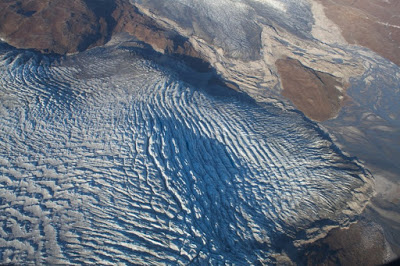
According to a new study published in Nature Geoscience, the Greenland ice sheet has been shown to accelerate in response to surface rainfall and melt associated with late-summer and autumnal cyclonic weather events.
Samuel Doyle and an international team of colleagues led from Aberystwyth University’s Centre for Glaciology combined records of ice motion, water pressure at the ice sheet bed, and river discharge with surface meteorology across the western margin of the Greenland ice sheet and captured the wide-scale effects of an unusual week of warm, wet weather in late August and early September, 2011.
They found that the cyclonic weather system led to extreme surface runoff — a combination of ice melt and rain — that overwhelmed the ice sheet’s basal drainage system, driving a marked increase in ice flow across the entire western sector of the ice sheet and extending 140 km into the ice sheet’s interior.
“It is like an urban sewerage system that is temporarily overwhelmed by an intense rain-storm. The ice sheet plumbing — literally a network of pipes, cavities and channels — gets backed up by the sheer quantity of runoff draining into it, leading to flooding and high water pressures, which literally hydraulically lifts the ice sheet up off its bed, reducing basal friction and sending it on its way,” said Prof Alun Hubbard the principal investigator who led the 4-year project which was funded by Natural Environment Research Council (NERC) and the Royal Geographical Society amongst others.
This particular depression prevailed across a broad swathe of southern and western Greenland, and a correspondingly-widespread acceleration in ice motion was reported from all available satellite and GPS tracking stations. This response was apparent at glaciers that terminate on dry land as well as those that calve into the sea.
Cyclonic systems, or depressions, are no great surprise to us in the UK and western Europe where, even in summer, they are unfortunately part and parcel of our everyday weather — commonly bringing wind and rain. In contrast, such conditions are less common across Greenland, which is normally dominated by a stable, high-pressure system centred over the ice sheet.
The influence of such rainfall events has not, until now, been considered in assessments of the melt and flow response of any ice sheet. This is an important omission because, although such cyclonic conditions are currently rare across Greenland, they are predicted to increase in the future, therefore likely playing an increasing role in driving mass loss from the Greenland ice sheet, which currently contributes over 0.7 mm per year to global sea-level — a rate at least double that of Antarctica.
“The late-summer timing was critical. The event occurred after the end of the melt season and the ice-sheet’s drainage system had started to close down. In this state the ice sheet’s drainage system just couldn’t cope,” said Dr Samuel Doyle, lead author of the study.
Since the 1980s when rainfall measurements began in the west Greenland town of Kangerlussuaq, the focus of the study, the proportion of precipitation now falling as rain rather than snow has both increased and extended into the late summer and autumn in line with increased circulation and moisture availability within a warmer, more energetic atmosphere.
“We’re seeing that warm wet weather is increasing with climate change and is driving more melt of the Greenland ice-sheet than we thought. And worryingly, this melt is now reaching ever higher elevations on the ice sheet” says Prof. Jason Box, one of the co- authors of the study.
“The jury is out as to whether the ‘rainfall’ events identified in our study had a lasting influence on the evolution of the Greenland ice sheet. Just like in many regions of the planet, observed climate warming doesn’t just mean hotter summers and milder winters; it’s more complex than that and more often it means more intense storm events at unusual times of the year just like we’ve witnessed here in the UK. These events are predicted to increase in the future and under a succession of such autumnal storm events there is no doubt the ice sheet will experience accelerated melt and flow which could only hasten its eventual demise,” commented Alun Hubbard.
Reference:
Samuel H. Doyle, Alun Hubbard, Roderik S.W. van de Wal, Jason E. Box, Dirk van As, Killian Scharrer, Toby W. Meierbachtol, Paul C.J.P. Smeets, Joel T. Harper, Emma Johansson, Ruth H. Mottram, Andreas B. Mikkelsen, Frank Wilhelms, Henry Patton, Poul Christoffersen, and Bryn Hubbard. Amplified melt and flow of the Greenland ice sheet driven by late-summer cyclonic rainfall. Nature Geoscience, July 2015 DOI: 10.1038/ngeo2482
Note: The above post is reprinted from materials provided by Aberystwyth University.










